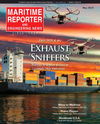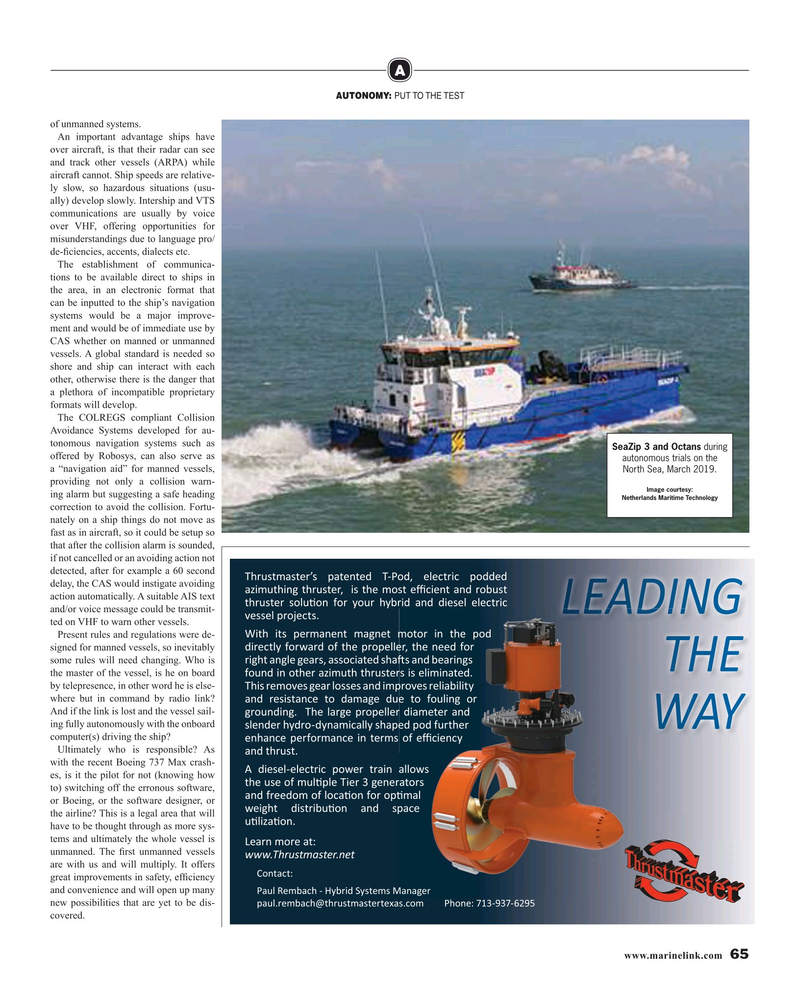
Page 65: of Maritime Reporter Magazine (May 2019)
Propulsion Annual - Green Marine Tech
Read this page in Pdf, Flash or Html5 edition of May 2019 Maritime Reporter Magazine
A
AUTONOMY: PUT TO THE TEST of unmanned systems.
An important advantage ships have over aircraft, is that their radar can see and track other vessels (ARPA) while aircraft cannot. Ship speeds are relative- ly slow, so hazardous situations (usu- ally) develop slowly. Intership and VTS communications are usually by voice over VHF, offering opportunities for misunderstandings due to language pro/ de-? ciencies, accents, dialects etc.
The establishment of communica- tions to be available direct to ships in the area, in an electronic format that can be inputted to the ship’s navigation systems would be a major improve- ment and would be of immediate use by
CAS whether on manned or unmanned vessels. A global standard is needed so shore and ship can interact with each other, otherwise there is the danger that a plethora of incompatible proprietary formats will develop.
The COLREGS compliant Collision
Avoidance Systems developed for au- tonomous navigation systems such as
SeaZip 3 and Octans during offered by Robosys, can also serve as autonomous trials on the a “navigation aid” for manned vessels,
North Sea, March 2019. providing not only a collision warn-
Image courtesy: ing alarm but suggesting a safe heading
Netherlands Maritime Technology correction to avoid the collision. Fortu- nately on a ship things do not move as fast as in aircraft, so it could be setup so that after the collision alarm is sounded, if not cancelled or an avoiding action not detected, after for example a 60 second
Thrustmaster’s patented T-Pod, electric podded delay, the CAS would instigate avoiding
A?sw?lSsYOlS???lG??s?lSGwŽ?lG?ÐsGYlAYE?Žd??l action automatically. A suitable AIS text lS???lG??Žu?OŽYIŽ??Ž??S?d?sEAYEEsG?GuGuGÐl?sÐ and/or voice message could be transmit- vessel projects. ted on VHF to warn other vessels.
With its permanent magnet motor in the pod
Present rules and regulations were de-
Es?GÐlu?IŽ??A?EŽIlSGÐ?ŽÐGuuG??lSGYGGEIŽ?
signed for manned vessels, so inevitably some rules will need changing. Who is ?sOSlAYOuGOGA???A??ŽÐsAlGE?SAO?AYEdGA?sYO?
the master of the vessel, is he on board
IŽ?YEsYŽlSG?A?sw?lSlS???lG??s?GuswsYAlGE?
by telepresence, in other word he is else- dSs??GwŽ|G?OGA?uŽ??G?AYEswÐ?Ž|G??GusAdsusl?
where but in command by radio link?
AYE?G?s?lAYÐGlŽEAwAOGE?GlŽIŽ?usYOŽ?
And if the link is lost and the vessel sail- grounding. The large propeller diameter and ing fully autonomously with the onboard ?uGYEG?S?E?Ž?E?YAwsÐAuu??SAÐGEÐŽEI??lSG?
computer(s) driving the ship?
GYSAYÐGÐG?IŽ?wAYÐGsYlG?w?ŽIG?ÐsGYÐ?
Ultimately who is responsible? As and thrust.
with the recent Boeing 737 Max crash-
EsG?Gu?GuGÐl?sÐÐŽ?G?l?AsYAuuŽ??
es, is it the pilot for not (knowing how lSG??GŽIw?uOÐuGdsG??OGYG?AlŽ??
to) switching off the erronous software,
AYEI?GGEŽwŽIuŽÐAOŽYIŽ?ŽÐOwAu or Boeing, or the software designer, or ?GsOSlEs?l?sd?OŽYAYE?ÐAÐG the airline? This is a legal area that will ?Ous?AOŽY?
have to be thought through as more sys- tems and ultimately the whole vessel is
Learn more at: unmanned. The ? rst unmanned vessels www.Thrustmaster.net are with us and will multiply. It offers
Contact: great improvements in safety, ef? ciency and convenience and will open up many
WA?uZGwdAÐS?,?d?sE^??lGw?DAYAOG?
new possibilities that are yet to be dis-
ÐA?u??GwdAÐS?lS???lwA?lG?lG?A??ÐŽwWSŽYG?????????????
covered.
www.marinelink.com 65
MR #5 (58-65).indd 65 5/3/2019 4:21:06 PM

 64
64

 66
66
